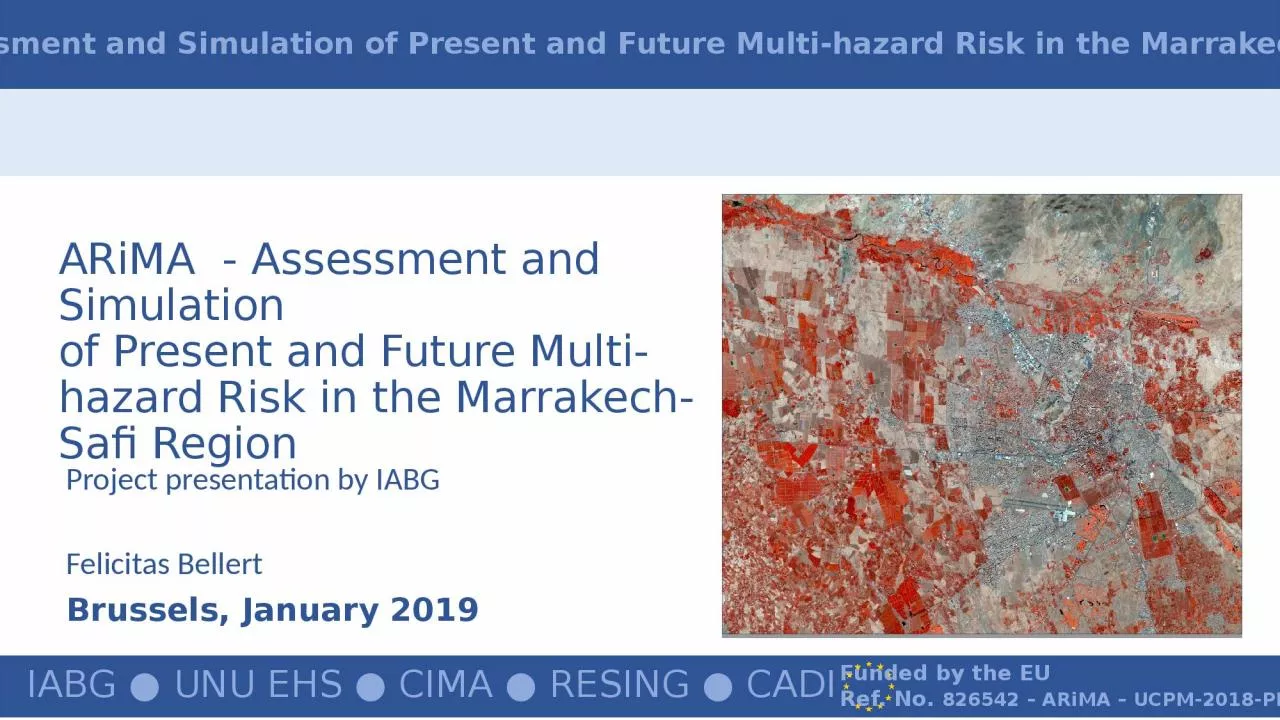

of Present and Future Multihazard Risk in the MarrakechSafi Region Project presentation by IABG Felicitas Bellert Brussels January 2019 Consortium amp Budget Coordinator ID: 1019164
Download Presentation The PPT/PDF document "ARiMA - Assessment and Simulation" is the property of its rightful owner. Permission is granted to download and print the materials on this web site for personal, non-commercial use only, and to display it on your personal computer provided you do not modify the materials and that you retain all copyright notices contained in the materials. By downloading content from our website, you accept the terms of this agreement.
1. ARiMA - Assessment and Simulation of Present and Future Multi-hazard Risk in the Marrakech-Safi Region Project presentation by IABG Felicitas BellertBrussels, January 2019
2. Consortium & BudgetCoordinator: IABG mbH (Germany)Project Partners: UNITED NATIONS UNIVERSITY Institute for Environment and Human Security (UNU-EHS) • GermanyCIMA • ItalyRESING • MoroccoUniversity Cadi Ayyad • MoroccoBeneficiaries:Hydraulic agency, Urban agency, Agriculture agency, Civil protection, Forest and Water Agency, local authorities • MoroccoExternal budget - Prevention priority Pilot and demonstration project focusing on regional resilience to disastersTotal eligible costs: EUR 929,409.49 EC co-financing: EUR 697,057 (75 %)Project duration: 24 months 01.01.2019 – 31.12.2020Area of activity: Marrakech-Safi Region – Morocco
3. Core Activities & Work packagesWP 1: Management & coordinationPhase I - 2019WP 2: User needs & stakeholder engagementWP 3: Development & production geo-spatial database for multi-hazard risk assessmentPhase II – 2019/2020WP 4: Multi-hazard risk assessment WP 5: Future scenarios of multi-hazard riskPhase III - 2020WP 6: Development of a spatial multi-hazard risk information platformWP 7: Analysis of prevention strategiesWP 8: Capacity building & knowledge transfer
4. Objectives of the ProjectDevelopment of a spatial multi-hazard risk information system (floods, drought, erosion) for Marrakech-Safi Region – Morocco Support disaster risk decision making by improving risk-informed rural and urban planningEvaluate the drivers, delineate the hotspots and understand the dynamics of current and future single and multi-hazard disaster riskMainstream the acquired knowledge into the regional prevention actions.RiskVulnerabilityExposureHazard
5. Main Benefits for SustainabilityImplementation of a system based on accessible data (f.e. Copernicus) and local or national data.Intensive trainings for Moroccan public authorities to maintain the risk assessment process to operate the system on their ownSet of a governance system (implementation/ monitoring) for the sustainability of its use.Improved awareness for sustainable planning and the use of natural resources.Contribution to increase capacity for preventing or reducing the impacts of future hazardous events
6. Expected Results & Next StepsRegional risk information system to identify current and future multi-hazard risk zones in its geospatial context.Decision making and planning tool for better management and prevention activities facing potential future risks within the Region.Involvement of Moroccan regional and national partners in all processes during the project lifetime to ensure acceptance and usability of outputs.Complement local and national activities and fit into the national plan for disaster risk prevention.KO and 1st Workshop in Marrakech (Jan/March 2019)Stakeholder engagement, data collection, interviews, field visits (Jan/March 2019 ff)Launch communication/ dissemination actions (Feb 2019 ff)
7. ContactsIABG mbHFelicitas Bellert Sandra MezzadriGeodata/GeoinfirmaticsEinsteinstrasse 2085521 OttobrunnGermanyPhone +49 89 6088-3299Bellert@iabg.deMezzadri@partner.iabg.dewww.iabg.deUnited Nations University - EHSMichael HagenlocherMostapha HarbInstitute for Environment and Human SecurityPlatz der Vereinten Nationen 153113 Bonn GermanyPhone +49-228-815-0250hagenlocher@ehs.unu.eduharb@ehs.unu.eduwww.ehs.unu.edu CIMARoberto RudariEva Trasforini Disaster Risk Reduction and Climate Change Adaption Via A.Magliotto, 2 17100 SavonaItalyPhone +39 019230271roberto.rudari@cimafoundation.orgeva.trasforini@cimafoundation.orgwww.cimafoundation.orgRESINGMohamed AboufirassAurélie Chancel435 Rue Annanhda Annakhil40016 , MarrakechMoroccoPhone +212524329817+212524329818m.aboufirass@resing.maa.chancel@resing.mawww.resing.maUniversity Cadi AyyadKhalid Rkha ChahamFaculté des Sciences-Semlalia, Laboratoire 3geo-labBoulevard Prince Moulay Abdellah40000, Marrakech MoroccoPhone +212-524434885rkha@uca.ac.mawww.ucam.maThank you for your attention! Arima.iabg.de
8. Activities and MilestonesStakeholder engagement and participationPhase IPhase IIPhase III